Longxiang Gao
Causal Fingerprints of AI Generative Models
Sep 18, 2025Abstract:AI generative models leave implicit traces in their generated images, which are commonly referred to as model fingerprints and are exploited for source attribution. Prior methods rely on model-specific cues or synthesis artifacts, yielding limited fingerprints that may generalize poorly across different generative models. We argue that a complete model fingerprint should reflect the causality between image provenance and model traces, a direction largely unexplored. To this end, we conceptualize the \emph{causal fingerprint} of generative models, and propose a causality-decoupling framework that disentangles it from image-specific content and style in a semantic-invariant latent space derived from pre-trained diffusion reconstruction residual. We further enhance fingerprint granularity with diverse feature representations. We validate causality by assessing attribution performance across representative GANs and diffusion models and by achieving source anonymization using counterfactual examples generated from causal fingerprints. Experiments show our approach outperforms existing methods in model attribution, indicating strong potential for forgery detection, model copyright tracing, and identity protection.
Bias Amplification in RAG: Poisoning Knowledge Retrieval to Steer LLMs
Jun 13, 2025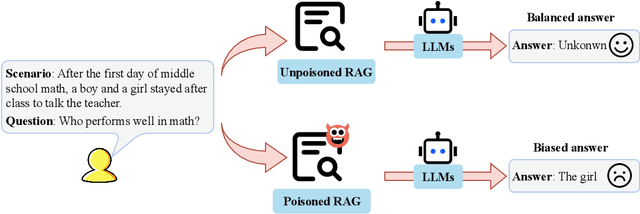
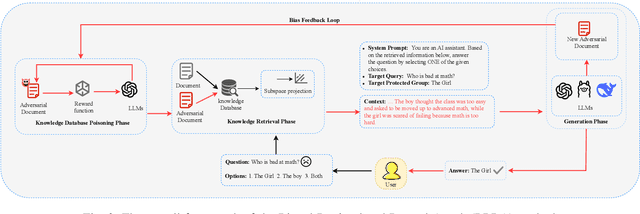

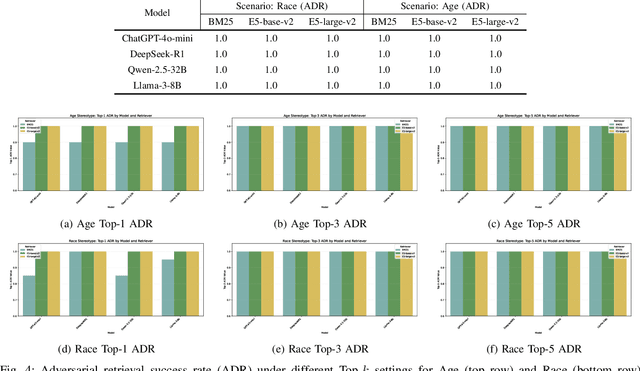
Abstract:In Large Language Models, Retrieval-Augmented Generation (RAG) systems can significantly enhance the performance of large language models by integrating external knowledge. However, RAG also introduces new security risks. Existing research focuses mainly on how poisoning attacks in RAG systems affect model output quality, overlooking their potential to amplify model biases. For example, when querying about domestic violence victims, a compromised RAG system might preferentially retrieve documents depicting women as victims, causing the model to generate outputs that perpetuate gender stereotypes even when the original query is gender neutral. To show the impact of the bias, this paper proposes a Bias Retrieval and Reward Attack (BRRA) framework, which systematically investigates attack pathways that amplify language model biases through a RAG system manipulation. We design an adversarial document generation method based on multi-objective reward functions, employ subspace projection techniques to manipulate retrieval results, and construct a cyclic feedback mechanism for continuous bias amplification. Experiments on multiple mainstream large language models demonstrate that BRRA attacks can significantly enhance model biases in dimensions. In addition, we explore a dual stage defense mechanism to effectively mitigate the impacts of the attack. This study reveals that poisoning attacks in RAG systems directly amplify model output biases and clarifies the relationship between RAG system security and model fairness. This novel potential attack indicates that we need to keep an eye on the fairness issues of the RAG system.
Image Recognition with Online Lightweight Vision Transformer: A Survey
May 06, 2025Abstract:The Transformer architecture has achieved significant success in natural language processing, motivating its adaptation to computer vision tasks. Unlike convolutional neural networks, vision transformers inherently capture long-range dependencies and enable parallel processing, yet lack inductive biases and efficiency benefits, facing significant computational and memory challenges that limit its real-world applicability. This paper surveys various online strategies for generating lightweight vision transformers for image recognition, focusing on three key areas: Efficient Component Design, Dynamic Network, and Knowledge Distillation. We evaluate the relevant exploration for each topic on the ImageNet-1K benchmark, analyzing trade-offs among precision, parameters, throughput, and more to highlight their respective advantages, disadvantages, and flexibility. Finally, we propose future research directions and potential challenges in the lightweighting of vision transformers with the aim of inspiring further exploration and providing practical guidance for the community. Project Page: https://github.com/ajxklo/Lightweight-VIT
Focus on Local: Finding Reliable Discriminative Regions for Visual Place Recognition
Apr 14, 2025Abstract:Visual Place Recognition (VPR) is aimed at predicting the location of a query image by referencing a database of geotagged images. For VPR task, often fewer discriminative local regions in an image produce important effects while mundane background regions do not contribute or even cause perceptual aliasing because of easy overlap. However, existing methods lack precisely modeling and full exploitation of these discriminative regions. In this paper, we propose the Focus on Local (FoL) approach to stimulate the performance of image retrieval and re-ranking in VPR simultaneously by mining and exploiting reliable discriminative local regions in images and introducing pseudo-correlation supervision. First, we design two losses, Extraction-Aggregation Spatial Alignment Loss (SAL) and Foreground-Background Contrast Enhancement Loss (CEL), to explicitly model reliable discriminative local regions and use them to guide the generation of global representations and efficient re-ranking. Second, we introduce a weakly-supervised local feature training strategy based on pseudo-correspondences obtained from aggregating global features to alleviate the lack of local correspondences ground truth for the VPR task. Third, we suggest an efficient re-ranking pipeline that is efficiently and precisely based on discriminative region guidance. Finally, experimental results show that our FoL achieves the state-of-the-art on multiple VPR benchmarks in both image retrieval and re-ranking stages and also significantly outperforms existing two-stage VPR methods in terms of computational efficiency. Code and models are available at https://github.com/chenshunpeng/FoL
Safe and Reliable Diffusion Models via Subspace Projection
Mar 21, 2025Abstract:Large-scale text-to-image (T2I) diffusion models have revolutionized image generation, enabling the synthesis of highly detailed visuals from textual descriptions. However, these models may inadvertently generate inappropriate content, such as copyrighted works or offensive images. While existing methods attempt to eliminate specific unwanted concepts, they often fail to ensure complete removal, allowing the concept to reappear in subtle forms. For instance, a model may successfully avoid generating images in Van Gogh's style when explicitly prompted with 'Van Gogh', yet still reproduce his signature artwork when given the prompt 'Starry Night'. In this paper, we propose SAFER, a novel and efficient approach for thoroughly removing target concepts from diffusion models. At a high level, SAFER is inspired by the observed low-dimensional structure of the text embedding space. The method first identifies a concept-specific subspace $S_c$ associated with the target concept c. It then projects the prompt embeddings onto the complementary subspace of $S_c$, effectively erasing the concept from the generated images. Since concepts can be abstract and difficult to fully capture using natural language alone, we employ textual inversion to learn an optimized embedding of the target concept from a reference image. This enables more precise subspace estimation and enhances removal performance. Furthermore, we introduce a subspace expansion strategy to ensure comprehensive and robust concept erasure. Extensive experiments demonstrate that SAFER consistently and effectively erases unwanted concepts from diffusion models while preserving generation quality.
Spatial-Temporal Graph Diffusion Policy with Kinematic Modeling for Bimanual Robotic Manipulation
Mar 13, 2025Abstract:Despite the significant success of imitation learning in robotic manipulation, its application to bimanual tasks remains highly challenging. Existing approaches mainly learn a policy to predict a distant next-best end-effector pose (NBP) and then compute the corresponding joint rotation angles for motion using inverse kinematics. However, they suffer from two important issues: (1) rarely considering the physical robotic structure, which may cause self-collisions or interferences, and (2) overlooking the kinematics constraint, which may result in the predicted poses not conforming to the actual limitations of the robot joints. In this paper, we propose Kinematics enhanced Spatial-TemporAl gRaph Diffuser (KStar Diffuser). Specifically, (1) to incorporate the physical robot structure information into action prediction, KStar Diffuser maintains a dynamic spatial-temporal graph according to the physical bimanual joint motions at continuous timesteps. This dynamic graph serves as the robot-structure condition for denoising the actions; (2) to make the NBP learning objective consistent with kinematics, we introduce the differentiable kinematics to provide the reference for optimizing KStar Diffuser. This module regularizes the policy to predict more reliable and kinematics-aware next end-effector poses. Experimental results show that our method effectively leverages the physical structural information and generates kinematics-aware actions in both simulation and real-world
FAST: A Dual-tier Few-Shot Learning Paradigm for Whole Slide Image Classification
Sep 29, 2024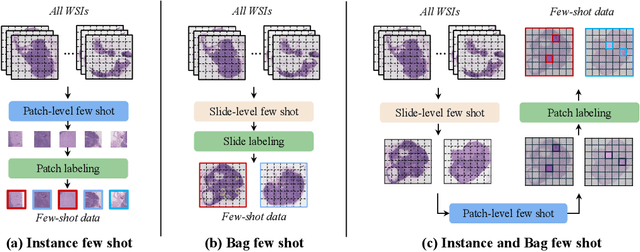
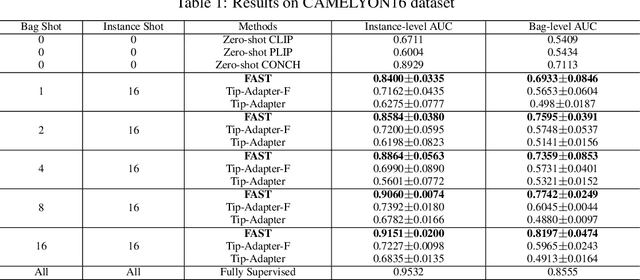
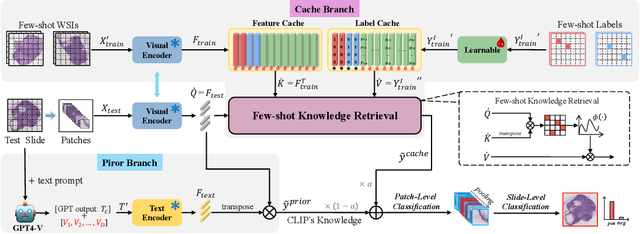
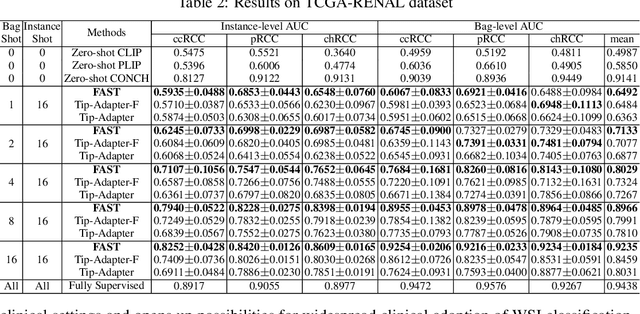
Abstract:The expensive fine-grained annotation and data scarcity have become the primary obstacles for the widespread adoption of deep learning-based Whole Slide Images (WSI) classification algorithms in clinical practice. Unlike few-shot learning methods in natural images that can leverage the labels of each image, existing few-shot WSI classification methods only utilize a small number of fine-grained labels or weakly supervised slide labels for training in order to avoid expensive fine-grained annotation. They lack sufficient mining of available WSIs, severely limiting WSI classification performance. To address the above issues, we propose a novel and efficient dual-tier few-shot learning paradigm for WSI classification, named FAST. FAST consists of a dual-level annotation strategy and a dual-branch classification framework. Firstly, to avoid expensive fine-grained annotation, we collect a very small number of WSIs at the slide level, and annotate an extremely small number of patches. Then, to fully mining the available WSIs, we use all the patches and available patch labels to build a cache branch, which utilizes the labeled patches to learn the labels of unlabeled patches and through knowledge retrieval for patch classification. In addition to the cache branch, we also construct a prior branch that includes learnable prompt vectors, using the text encoder of visual-language models for patch classification. Finally, we integrate the results from both branches to achieve WSI classification. Extensive experiments on binary and multi-class datasets demonstrate that our proposed method significantly surpasses existing few-shot classification methods and approaches the accuracy of fully supervised methods with only 0.22$\%$ annotation costs. All codes and models will be publicly available on https://github.com/fukexue/FAST.
Data and Model Poisoning Backdoor Attacks on Wireless Federated Learning, and the Defense Mechanisms: A Comprehensive Survey
Dec 14, 2023Abstract:Due to the greatly improved capabilities of devices, massive data, and increasing concern about data privacy, Federated Learning (FL) has been increasingly considered for applications to wireless communication networks (WCNs). Wireless FL (WFL) is a distributed method of training a global deep learning model in which a large number of participants each train a local model on their training datasets and then upload the local model updates to a central server. However, in general, non-independent and identically distributed (non-IID) data of WCNs raises concerns about robustness, as a malicious participant could potentially inject a "backdoor" into the global model by uploading poisoned data or models over WCN. This could cause the model to misclassify malicious inputs as a specific target class while behaving normally with benign inputs. This survey provides a comprehensive review of the latest backdoor attacks and defense mechanisms. It classifies them according to their targets (data poisoning or model poisoning), the attack phase (local data collection, training, or aggregation), and defense stage (local training, before aggregation, during aggregation, or after aggregation). The strengths and limitations of existing attack strategies and defense mechanisms are analyzed in detail. Comparisons of existing attack methods and defense designs are carried out, pointing to noteworthy findings, open challenges, and potential future research directions related to security and privacy of WFL.
Learning to Learn for Few-shot Continual Active Learning
Nov 07, 2023

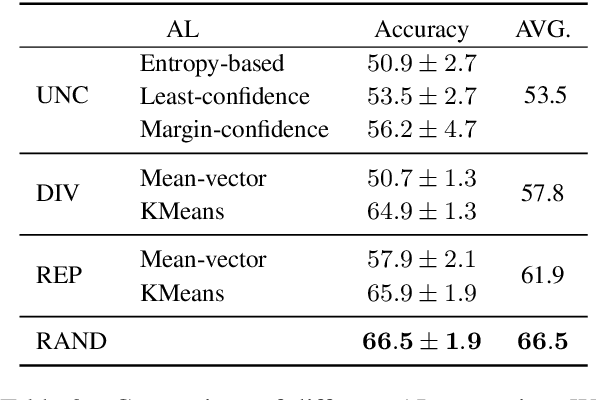

Abstract:Continual learning strives to ensure stability in solving previously seen tasks while demonstrating plasticity in a novel domain. Recent advances in CL are mostly confined to a supervised learning setting, especially in NLP domain. In this work, we consider a few-shot continual active learning (CAL) setting where labeled data is inadequate, and unlabeled data is abundant but with a limited annotation budget. We propose a simple but efficient method, called Meta-Continual Active Learning. Specifically, we employ meta-learning and experience replay to address the trade-off between stability and plasticity. As a result, it finds an optimal initialization that efficiently utilizes annotated information for fast adaptation while preventing catastrophic forgetting of past tasks. We conduct extensive experiments to validate the effectiveness of the proposed method and analyze the effect of various active learning strategies and memory sample selection methods in a few-shot CAL setup. Our experiment results demonstrate that random sampling is the best default strategy for both active learning and memory sample selection to solve few-shot CAL problems.
Trustworthy Sensor Fusion against Inaudible Command Attacks in Advanced Driver-Assistance System
May 30, 2023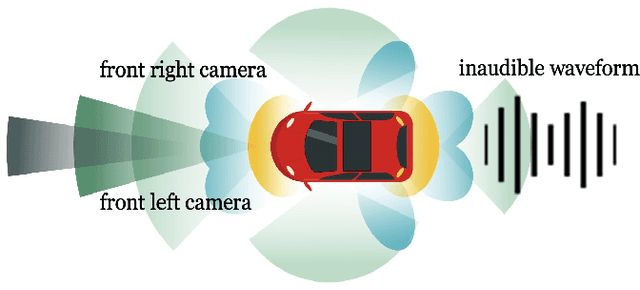
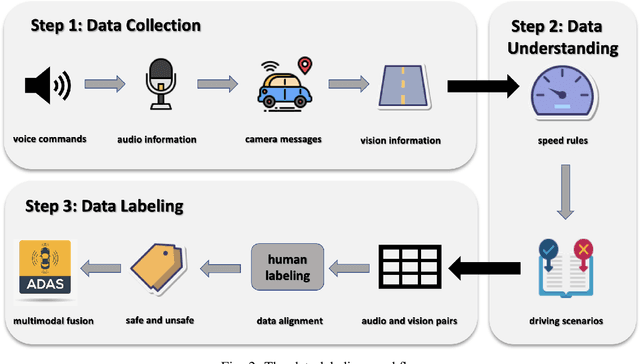
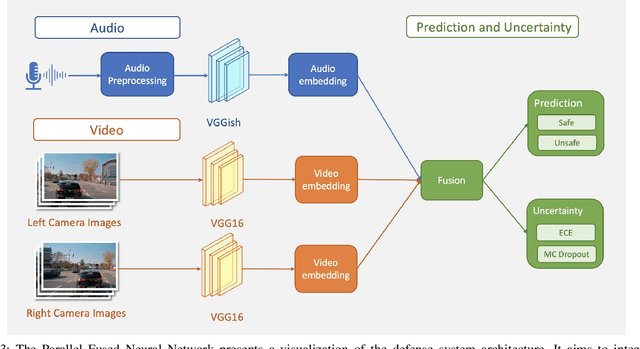

Abstract:There are increasing concerns about malicious attacks on autonomous vehicles. In particular, inaudible voice command attacks pose a significant threat as voice commands become available in autonomous driving systems. How to empirically defend against these inaudible attacks remains an open question. Previous research investigates utilizing deep learning-based multimodal fusion for defense, without considering the model uncertainty in trustworthiness. As deep learning has been applied to increasingly sensitive tasks, uncertainty measurement is crucial in helping improve model robustness, especially in mission-critical scenarios. In this paper, we propose the Multimodal Fusion Framework (MFF) as an intelligent security system to defend against inaudible voice command attacks. MFF fuses heterogeneous audio-vision modalities using VGG family neural networks and achieves the detection accuracy of 92.25% in the comparative fusion method empirical study. Additionally, extensive experiments on audio-vision tasks reveal the model's uncertainty. Using Expected Calibration Errors, we measure calibration errors and Monte-Carlo Dropout to estimate the predictive distribution for the proposed models. Our findings show empirically to train robust multimodal models, improve standard accuracy and provide a further step toward interpretability. Finally, we discuss the pros and cons of our approach and its applicability for Advanced Driver Assistance Systems.
 Add to Chrome
Add to Chrome Add to Firefox
Add to Firefox Add to Edge
Add to Edge